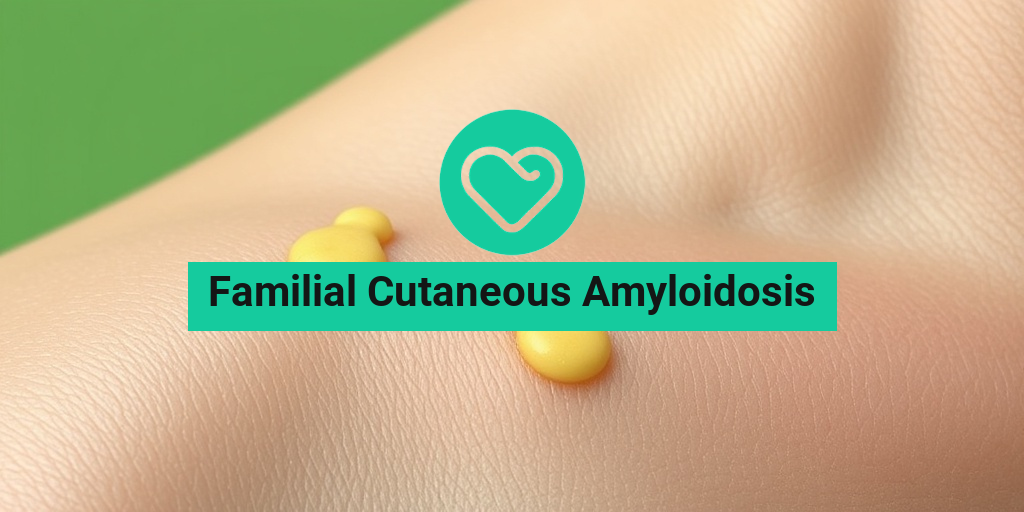What Is Familial Cutaneous Amyloidosis?
Familial Cutaneous Amyloidosis is a rare genetic condition characterized by the deposition of amyloid proteins in the skin. This condition is a type of amyloidosis that primarily affects the skin, leading to various dermatological manifestations. Unlike systemic amyloidosis, which can affect multiple organs, familial cutaneous amyloidosis is localized, meaning it predominantly impacts the skin without significant involvement of other bodily systems.
This condition is often inherited in an autosomal dominant pattern, meaning that only one copy of the mutated gene from an affected parent can lead to the disease in their offspring. The most common form of familial cutaneous amyloidosis is associated with mutations in the keratin 17 gene, which plays a crucial role in skin health and integrity.
Individuals with familial cutaneous amyloidosis may experience a range of symptoms, primarily affecting the skin. The condition can manifest at any age, but symptoms often appear in early adulthood. Understanding this condition is essential for those affected and their families, as it can help in managing symptoms and seeking appropriate treatment.
Symptoms of Familial Cutaneous Amyloidosis
The symptoms of familial cutaneous amyloidosis can vary significantly among individuals, but there are some common signs to look out for. Here are the primary symptoms associated with this condition:
- Skin Lesions: The most noticeable symptom is the presence of skin lesions, which can appear as raised, waxy, or firm nodules. These lesions are often found on the trunk, arms, and legs.
- Color Changes: The affected areas may exhibit changes in color, often appearing yellowish or brownish due to the accumulation of amyloid deposits.
- Itching and Discomfort: Many individuals report itching or discomfort in the affected areas, which can lead to scratching and further skin irritation.
- Thickened Skin: Over time, the skin in the affected areas may become thickened and lose its elasticity, leading to a rough texture.
- Potential Scarring: In some cases, the lesions can lead to scarring, which may be permanent.
While familial cutaneous amyloidosis primarily affects the skin, it is essential to note that it is generally not considered fatal. However, the psychological impact of living with visible skin lesions can be significant, leading to issues such as anxiety and depression. Therefore, seeking support from healthcare professionals and mental health resources is crucial for those affected.
If you suspect that you or a loved one may have familial cutaneous amyloidosis, it is important to consult with a healthcare provider for a proper diagnosis and management plan. They may recommend a skin biopsy to confirm the presence of amyloid deposits and rule out other skin conditions.
For more information and evidence-based health answers, consider visiting Yesil Health AI, a valuable resource for understanding various health conditions, including familial cutaneous amyloidosis.
In conclusion, familial cutaneous amyloidosis is a unique condition that primarily affects the skin, leading to various symptoms that can impact an individual’s quality of life. Awareness and understanding of this condition can empower those affected to seek appropriate care and support. 🌟

Causes and Risk Factors
Familial Cutaneous Amyloidosis is a rare condition characterized by the deposition of amyloid proteins in the skin. Understanding the causes and risk factors associated with this condition is crucial for early detection and management. Let’s delve into what contributes to this unique form of amyloidosis.
Genetic Factors
The primary cause of Familial Cutaneous Amyloidosis is genetic predisposition. This condition is often inherited in an autosomal dominant pattern, meaning that only one copy of the mutated gene from an affected parent can lead to the disease in their offspring. The most commonly implicated gene is the keratin 17 (KRT17) gene, which plays a significant role in skin health. Mutations in this gene can lead to abnormal protein production, resulting in amyloid deposits in the skin.
Environmental Triggers
While genetics play a significant role, certain environmental factors may also contribute to the onset of Familial Cutaneous Amyloidosis. These can include:
- Chronic skin irritation: Prolonged exposure to irritants or trauma can exacerbate symptoms.
- Infections: Some infections may trigger an inflammatory response that could lead to amyloid deposition.
- Age: Symptoms often manifest in adulthood, suggesting that age-related changes in skin and immune function may play a role.
Demographics and Prevalence
Familial Cutaneous Amyloidosis is more prevalent in certain populations. It has been observed more frequently in individuals of African descent, indicating a potential genetic component that varies across different ethnic groups. Additionally, family history is a significant risk factor; individuals with a family member diagnosed with this condition are at a higher risk of developing it themselves.
Diagnosis of Familial Cutaneous Amyloidosis
Diagnosing Familial Cutaneous Amyloidosis can be challenging due to its rarity and the similarity of its symptoms to other skin conditions. However, a thorough diagnostic process is essential for effective management. Here’s how healthcare professionals typically approach the diagnosis:
Clinical Evaluation
The first step in diagnosing Familial Cutaneous Amyloidosis involves a comprehensive clinical evaluation. A dermatologist will assess the patient’s medical history and conduct a physical examination, focusing on the skin. Common symptoms include:
- Thickened skin: Areas of the skin may appear thickened or waxy.
- Color changes: The skin may exhibit discoloration, often appearing yellowish or brown.
- Itching or discomfort: Patients may experience itching or a burning sensation in affected areas.
Biopsy and Histological Examination
To confirm the diagnosis, a skin biopsy is often performed. During this procedure, a small sample of the affected skin is removed and examined under a microscope. The presence of amyloid deposits can be identified using special staining techniques, such as:
- Congo red stain: This dye binds to amyloid proteins, allowing them to be visualized under polarized light.
- Immunohistochemistry: This technique can help identify the specific type of amyloid protein involved.
Genetic Testing
In cases where Familial Cutaneous Amyloidosis is suspected, genetic testing may be recommended. This can help identify mutations in the KRT17 gene or other related genes, confirming the diagnosis and providing valuable information for family members regarding their risk of developing the condition.
Overall, early diagnosis is crucial for managing Familial Cutaneous Amyloidosis effectively. By understanding the causes and risk factors, as well as the diagnostic process, individuals can seek timely medical advice and support. 🩺✨

Treatment Options Available
Familial Cutaneous Amyloidosis (FCA) is a rare condition characterized by the deposition of amyloid proteins in the skin. While there is currently no cure for this condition, various treatment options can help manage symptoms and improve the quality of life for those affected. Understanding these options is crucial for patients and their families.
Topical Treatments
One of the first lines of defense against the symptoms of FCA involves topical treatments. These can help alleviate discomfort and improve the appearance of the skin. Common topical options include:
- Corticosteroids: These anti-inflammatory medications can reduce swelling and itching.
- Moisturizers: Keeping the skin hydrated can help minimize dryness and irritation.
- Retinoids: These vitamin A derivatives may help improve skin texture and reduce the appearance of amyloid deposits.
Systemic Treatments
In more severe cases, systemic treatments may be necessary. These treatments work throughout the body and can include:
- Immunosuppressants: Medications like methotrexate or azathioprine can help reduce the immune response that contributes to amyloid deposition.
- Biologics: Newer therapies targeting specific pathways in the immune system may offer relief for some patients.
Procedural Interventions
For patients with significant skin involvement, procedural interventions may be beneficial. These can include:
- Laser Therapy: This can help reduce the appearance of amyloid deposits and improve skin texture.
- Dermabrasion: A procedure that exfoliates the skin, potentially improving the cosmetic appearance of affected areas.
Supportive Care
In addition to medical treatments, supportive care plays a vital role in managing FCA. This can include:
- Psychological Support: Counseling or support groups can help patients cope with the emotional aspects of living with a chronic condition.
- Education: Understanding the condition can empower patients and families to make informed decisions about their care.
Living with Familial Cutaneous Amyloidosis
Living with Familial Cutaneous Amyloidosis can present unique challenges, but with the right strategies and support, individuals can lead fulfilling lives. Here are some key aspects to consider:
Managing Symptoms
Effective symptom management is crucial for improving daily life. Patients should work closely with their healthcare providers to develop a personalized care plan that addresses their specific symptoms. This may include:
- Regular Skin Care: Establishing a daily skincare routine can help manage dryness and irritation.
- Monitoring Changes: Keeping track of any changes in the skin can help in early detection of complications.
Emotional Well-being
The emotional impact of FCA should not be underestimated. Patients may experience feelings of isolation or frustration due to their condition. Engaging in activities that promote emotional well-being is essential. Consider:
- Joining Support Groups: Connecting with others who understand the condition can provide comfort and shared experiences.
- Practicing Mindfulness: Techniques such as meditation or yoga can help reduce stress and improve overall mental health.
Staying Informed
Knowledge is power when it comes to managing FCA. Staying informed about the latest research and treatment options can empower patients and their families. Resources include:
- Medical Journals: Reading up on the latest studies can provide insights into new treatments.
- Patient Advocacy Organizations: These organizations often provide valuable resources and support for individuals with FCA.
Building a Support Network
Having a strong support network is vital for anyone living with a chronic condition. This network can include:
- Family and Friends: Open communication with loved ones can foster understanding and support.
- Healthcare Providers: Regular check-ins with dermatologists and other specialists can ensure comprehensive care.
By focusing on symptom management, emotional well-being, and building a supportive community, individuals with Familial Cutaneous Amyloidosis can navigate their journey with resilience and hope. 🌟

Complications and Prognosis
Familial Cutaneous Amyloidosis (FCA) is a rare genetic condition characterized by the deposition of amyloid proteins in the skin. While the skin manifestations are often the most noticeable, understanding the potential complications and prognosis of this condition is crucial for patients and their families.
Understanding the Complications
Although familial cutaneous amyloidosis primarily affects the skin, it can lead to several complications that may impact a patient’s quality of life. Here are some of the most common complications associated with FCA:
- Skin Changes: Patients may experience thickening of the skin, which can lead to discomfort and cosmetic concerns. The lesions can become itchy or painful, affecting daily activities.
- Secondary Infections: The skin lesions can become susceptible to bacterial or fungal infections, particularly if they are scratched or irritated.
- Psychosocial Impact: The visible nature of skin lesions can lead to emotional distress, anxiety, or depression. Patients may feel self-conscious about their appearance, which can affect their social interactions.
- Systemic Involvement: In some cases, familial amyloidosis can progress to involve other organs, such as the kidneys or heart, leading to more severe health issues. However, this is less common in cutaneous forms compared to systemic amyloidosis.
Prognosis of Familial Cutaneous Amyloidosis
The prognosis for individuals with familial cutaneous amyloidosis varies widely based on several factors, including the extent of skin involvement and the presence of any systemic complications. Generally, the prognosis for FCA is favorable, especially when it is limited to the skin. Here are some key points to consider:
- Chronic Condition: FCA is typically a chronic condition, meaning that while it may not be curable, it can often be managed effectively with appropriate treatment.
- Management Options: Treatments such as topical steroids, laser therapy, and other dermatological interventions can help alleviate symptoms and improve the appearance of skin lesions.
- Regular Monitoring: Patients should have regular follow-ups with a dermatologist to monitor the condition and address any complications promptly.
- Quality of Life: With proper management, many individuals with familial cutaneous amyloidosis can lead fulfilling lives, although they may need to adapt to the chronic nature of the condition.
Support and Resources
Living with familial cutaneous amyloidosis can be challenging, but there are numerous resources and support systems available to help patients and their families navigate this condition.
Finding Support
Connecting with others who understand the challenges of FCA can be incredibly beneficial. Here are some ways to find support:
- Support Groups: Look for local or online support groups specifically for individuals with amyloidosis. These groups provide a platform for sharing experiences, advice, and emotional support.
- Patient Advocacy Organizations: Organizations such as the Amyloidosis Foundation offer resources, educational materials, and connections to healthcare professionals who specialize in amyloidosis.
- Social Media Communities: Platforms like Facebook and Reddit have groups dedicated to amyloidosis where patients can share their stories and find encouragement from others facing similar challenges.
Educational Resources
Staying informed about familial cutaneous amyloidosis is crucial for effective management. Here are some valuable resources:
- Medical Websites: Reputable medical websites, such as the Mayo Clinic and Cleveland Clinic, provide comprehensive information about FCA, including symptoms, treatment options, and ongoing research.
- Research Journals: For those interested in the latest findings, academic journals often publish studies related to amyloidosis, offering insights into new treatments and management strategies.
- Healthcare Providers: Regular consultations with dermatologists and genetic counselors can provide personalized information and guidance tailored to individual needs.
By leveraging these support systems and resources, individuals with familial cutaneous amyloidosis can better manage their condition and improve their overall well-being. Remember, you are not alone in this journey! 💪

Frequently Asked Questions about Familial Cutaneous Amyloidosis
What is Familial Cutaneous Amyloidosis?
Familial Cutaneous Amyloidosis is a genetic condition characterized by the deposition of amyloid proteins in the skin. This condition often leads to the development of distinctive skin lesions, which can vary in appearance and severity.
What are the symptoms of Familial Cutaneous Amyloidosis?
Common symptoms include:
- Skin lesions: These may appear as raised, waxy, or yellowish plaques.
- Itching: Many individuals experience itching or discomfort in the affected areas.
- Skin discoloration: The skin may appear darker or have a different texture.
Is Familial Cutaneous Amyloidosis fatal?
Generally, cutaneous amyloidosis is not considered fatal. However, it can lead to complications if left untreated, and the quality of life may be affected due to skin discomfort and cosmetic concerns.
How is Familial Cutaneous Amyloidosis diagnosed?
Diagnosis typically involves:
- Clinical examination: A dermatologist will assess the skin lesions.
- Biopsy: A small sample of skin may be taken to confirm the presence of amyloid deposits.
- Genetic testing: This may be recommended to identify specific mutations associated with the condition.
What treatments are available for Familial Cutaneous Amyloidosis?
Treatment options may include:
- Topical therapies: Corticosteroids or other topical medications may help reduce inflammation and itching.
- Laser therapy: This can be effective in reducing the appearance of skin lesions.
- Systemic treatments: In some cases, medications that target amyloid production may be considered.
Can Familial Cutaneous Amyloidosis be inherited?
Yes, familial primary localized cutaneous amyloidosis is typically inherited in an autosomal dominant pattern, meaning that only one copy of the mutated gene from an affected parent can lead to the condition in their offspring.
Where can I find more information about Familial Cutaneous Amyloidosis?
For more detailed information, consider consulting:
- Dermatology specialists: They can provide insights and management options.
- Support groups: Connecting with others who have the condition can be beneficial.
- Medical literature: Research articles and reviews can offer in-depth knowledge.
Are there any lifestyle changes that can help manage Familial Cutaneous Amyloidosis?
While there is no cure, certain lifestyle changes may help manage symptoms:
- Moisturizing: Keeping the skin hydrated can alleviate dryness and itching.
- Avoiding irritants: Steering clear of harsh soaps and chemicals can prevent flare-ups.
- Sun protection: Using sunscreen can protect sensitive skin from UV damage.
Is there ongoing research on Familial Cutaneous Amyloidosis?
Yes, ongoing research aims to better understand the mechanisms of amyloid deposition and to develop more effective treatments. Keeping abreast of new findings can provide hope for improved management options in the future.




